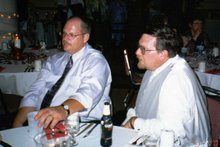The Wisconsin Soybean Association released their report regarding the feasability of locating a crush facility in Southern Wisconsin yesterday. Below are some excerpts from the Executive Summary. Follow this link for the full report.
[snip]
An 80,000 bushel/day soybean plant located in south central Wisconsin would need to buy about 40% of the soybean crop in southern and eastern Wisconsin and the northern tier of counties in Illinois to operate at capacity.
[snip]
With so many soybeans leaving Wisconsin and going a great distance to find markets, and so much meal coming into the state from so far away, it should be profitable to process the soybeans within the state. However, a soybean processing plant also makes oil in addition to meal, and until now there has not been an acceptable market for the oil.
The soybean oil refining industry in the United States has evolved to the point where 85% of the active refining capacity is at crush plants. The crusher/refiner has almost entirely replaced the stand-alone refiner. There still are a few stand-alone refiners of crude soybean oil (such as J.M. Smucker, the owner of the Crisco label, at Ivorydale, Cincinnati) and a few who buy semi-refined (refined and bleached, or RB) oil, and do the final deodorizing step themselves (such as Loders Croklaan near Joliet, Illinois). But by-and-large the owners of branded oils are out of the refining business, buying their product from the crusher/refiners and concentrating their own resources on marketing and brand management.
It would be difficult for a new entrant to the soybean oil market, either crude or refined, to establish itself in this already well-established market. However, with the advent of biodiesel, the situation has changed.
[snip]
Of particular interest to a soybean processor in southern Wisconsin are the stand-alone biodiesel plants that are or will be in proximity to the plant. There are five such plants. Two are already operating―Stepan Company near Joliet, which recently doubled their capacity to 22 MGY (and has plans to double it again), and Renewable Alternatives at Manitowoc. This plant currently is very small―less than 500,000 gallons/year. But an expansion to 3 MGY is in progress and another 3 MGY is planned. Two plants are under construction. Anamax recently began construction of a 20 MGY biodiesel plant at De Forest that is expected to be in production by early 2007. This will be a multi-feedstock plant, some of which will be soybean oil. Ag Solutions is building a 10 MGY biodiesel plant at Gladstone, Michigan, in the Upper Peninsula, 60 miles up the shore of Lake Michigan from the Wisconsin-Michigan state line. Start-up is planned for this summer, with soybean oil being the feedstock. Finally, North Prairie Production (formerly North Prairie Energy) is in the design stage for a 45 MGY plant somewhere in southern Wisconsin.
These five biodiesel plants could take twice as much soybean oil as the plant would produce. (emphasis added) Four expressed very strong interest in having a supplier of soybean oil in southern Wisconsin (Ag Solutions could not be contacted) and Anamax and North Prairie Production mentioned their interest in co-location with the soybean plant.
[snip]
An 80,000 bushel/day crush plant with similarly sized refinery for the production of RB oil is recommended. Estimated capital costs for such a facility, with adequate soybean and product storage, configured to allow for identity preserved (IP) processing, is $75 million. Fifty percent would be financed by a 10-year loan, with the rest financed by owner equity. Eleven million dollars of working capital will be needed, financed by a short-term loan.
The plant must be sited where there is good access to truck and rail transportation. Co-location with the biodiesel plant at De Forest or Waterloo would meet this requirement. So would locations such as Madison, Janesville, Evansville, Stoughton and Edgerton. Permitting and political hurdles will have to be cleared. Some communities might offer incentives, such as property tax relief for a number of years, to encourage that plant to locate there. (Again, emphasis mine)
[snip]
The plant can expect stiff competition from the crush plants who have long considered Wisconsin to be a primary market for their meal―ADM and CHS at Mankato, Cargill at Cedar Rapids and ADM at Galesburg.
Before making a “go” decision the Steering Committee should revise the financial model as they deem appropriate, determine what suitable locations would be interested in having the plant near their community and perhaps offer incentives to locate there, get price quotations from the processing and refining equipment suppliers, and conduct further discussions with soybean shippers and meal and oil buyers in the primary, secondary and tertiary market areas.
Subscribe to:
Post Comments (Atom)



No comments:
Post a Comment